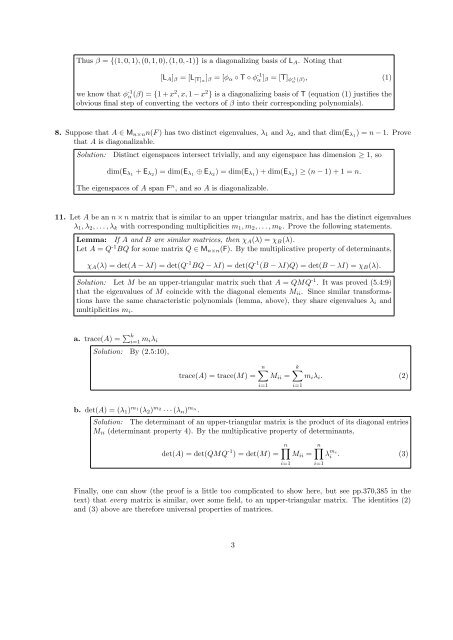Homework 7 Solutions
Homework 7 Solutions
Homework 7 Solutions
Create successful ePaper yourself
Turn your PDF publications into a flip-book with our unique Google optimized e-Paper software.
Thus β = {(1, 0, 1), (0, 1, 0), (1, 0, -1)} is a diagonalizing basis of LA. Noting that<br />
[LA]β = [L [T]α ]β = [φα ◦ T ◦ φ -1<br />
α ]β = [T] φ -1<br />
α (β), (1)<br />
we know that φ -1<br />
α (β) = {1 + x 2 , x, 1 − x 2 } is a diagonalizing basis of T (equation (1) justifies the<br />
obvious final step of converting the vectors of β into their corresponding polynomials).<br />
8. Suppose that A ∈ Mn×nn(F ) has two distinct eigenvalues, λ1 and λ2, and that dim(Eλ1 ) = n − 1. Prove<br />
that A is diagonalizable.<br />
Solution: Distinct eigenspaces intersect trivially, and any eigenspace has dimension ≥ 1, so<br />
dim(Eλ1<br />
+ Eλ2 ) = dim(Eλ1 ⊕ Eλ2 ) = dim(Eλ1 ) + dim(Eλ2 ) ≥ (n − 1) + 1 = n.<br />
The eigenspaces of A span F n , and so A is diagonalizable.<br />
11. Let A be an n × n matrix that is similar to an upper triangular matrix, and has the distinct eigenvalues<br />
λ1, λ2, . . . , λk with corresponding multiplicities m1, m2, . . . , mk. Prove the following statements.<br />
Lemma: If A and B are similar matrices, then χA(λ) = χB(λ).<br />
Let A = Q -1 BQ for some matrix Q ∈ Mn×n(F). By the multiplicative property of determinants,<br />
χA(λ) = det(A − λI) = det(Q -1 BQ − λI) = det(Q -1 (B − λI)Q) = det(B − λI) = χB(λ).<br />
Solution: Let M be an upper-triangular matrix such that A = QMQ -1 . It was proved (5.4:9)<br />
that the eigenvalues of M coincide with the diagonal elements Mii. Since similar transformations<br />
have the same characteristic polynomials (lemma, above), they share eigenvalues λi and<br />
multiplicities mi.<br />
a. trace(A) = k<br />
i=1 miλi<br />
Solution: By (2.5:10),<br />
b. det(A) = (λ1) m1 (λ2) m2 · · · (λn) mn .<br />
trace(A) = trace(M) =<br />
n<br />
Mii =<br />
i=1<br />
k<br />
miλi. (2)<br />
Solution: The determinant of an upper-triangular matrix is the product of its diagonal entries<br />
Mii (determinant property 4). By the multiplicative property of determinants,<br />
det(A) = det(QMQ -1 ) = det(M) =<br />
i=1<br />
n<br />
Mii =<br />
i=1<br />
n<br />
i=1<br />
λ mi<br />
i . (3)<br />
Finally, one can show (the proof is a little too complicated to show here, but see pp.370,385 in the<br />
text) that every matrix is similar, over some field, to an upper-triangular matrix. The identities (2)<br />
and (3) above are therefore universal properties of matrices.<br />
3
















